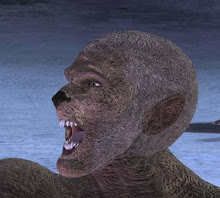History Channel -- Original Air Date: 7/8/2009
Guess what? Another bigfoot episode of MQ! I'm sure none of us saw that coming. (And just when I thought this season was over.) Okay, getting over that shock, you may be surprised to find that I share the opinion that Dr. David Begun (paleoanthropologist) expresses on this episode: "We don't have anything against the idea of bigfoot ... It's just that as scientists we require reliable, reproducable evidence, and that just doesn't exist right now." Among the show's "best evidence" the Freeman Blue Mountain Footage (1995), the Cripple-foot cast (1969), the Mid-Tarsal Break tracks, Sighting Density studies, and the (in)famous Patterson film (1967). The show will examine all of these, mixed in with the usual compelling eyewitness stories and recreations. Makeup man Bill Munns will examine the Patterson film. He uses scene measurements, the camera lense, and distance to subject to solve the figure's height -- and immediately gets questionable results (a 4' bigfoot). Clearly, some site measurements are not accurate. So the MQ team goes to the original site to re-measure using a 3d digital scanner. They take Bob Gimlen, the surviving "eyewitness," to help find the correct area -- but they're foiled when heavy snow prevents their helicopter from landing. So, it's back to the studio and more math. David Murphy, a Patterson biographer, believes the film is real. He claims Patterson passed a polygraph (according to Wildlife Magazine). The show mentions Patterson has been vilified, but doesn't mention any anti-Patterson details, undercutting their attempt at "balance." A film expert looks for signs of hoaxing on MQ's high-quality print, doing the usual enhancement stuff.
As that goes on, the show looks for sighting hotspots in relationship to annual precipitation - predicted to be crucial for survival of a large primate. Surpisingly, there are a lot of sightings in the east central as well as the west (usually associated with Bigfoot). As theorized, there seems to be a correlation betweein sightings and rainfall. Jeff Meldrum believes that, being a great ape, bigfoot tracks should have a mid-tarsal break, which human feet do not have. He uses lasers to scan prints and create models to see how the creature would walk. Meldrum also talks about the Freeman footage (which looks completely fake to me), which he clearly believes in. The footage is low quality, and resists serious enhancement (due to pixilation). Meldrum's "tarsal break" demonstration fails to convince me, too; it looks like the same kind of bend you'd get in someone wearing a big, fake foot. An MD opines that the Cripple Foot cast seems realistic and very difficult to hoax. (People have been saying that since my childhood, when the print first surfaced -- so nothing new there.)
Back at the Patterson film, re-creator Munns decides that the lens is different from the one reported because of calculation (he figures 15mm). He then re-creates the scene, re-calculates the creature's height at 7' 4", and then begins analyzing the proportions. To determine the head shape he builds 5 different heads to try and recreate the look of the film using what he believes is the actual camera and lens (not the reported one). Anthropologist Begun insists that the Patterson creature walks like a human, not an ape. (I don't even think he's seen the guy who walks like this in Is It Real?) But Munns opines the suit looks more real than materials at the time would allow. The film analyst ehnances the image, revealing what he believes are breasts as well as some face details -- but he is not willing to say whether the thing is a costume or not. Because of his mask recreation and his attempt to fit a (standard) human figure into the filmed figure, Munns believe the thing on the Patterson film is not human. So, in the end, scientists remain skeptical, analysts split, and belivers believe -- but we have little more light shed on the subject than before. All of the analyses done on this show have been done previously, with similar results. Even the new "evidence" of the camera lens size is educated guesswork, at best. So like most bigfoot "science," that analysis is based on hopes or guesses rather than anything truly reproducable. Of course, no matter on which side, opinions are not facts, and on MQ we routinely get opinions masquerading as more.
Sadly, again, none of the analysts ever compare the Patterson footage to footage of Bob Heironimus, who claims to have played the creature and can be seen on Is It Real? Failing to consider "best evidence against" means that "best evidence for" remains, at best, unconvincing. Why can't these shows build on each other's finding rather than recreating the same findings? MQ, like most shows of this type, is too interesting in selling commercial time to really dig deep and jeopardize a good story.
Wednesday, July 29, 2009
Subscribe to:
Post Comments (Atom)





No comments:
Post a Comment